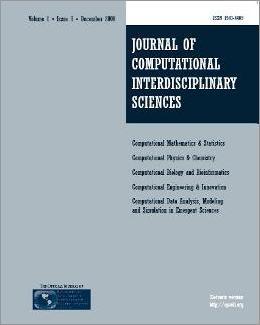
Editorial Office:
Management:
R. S. Oyarzabal
Technical Support:
D. H. Diaz
M. A. Gomez
W. Abrahão
G. Oliveira
Publisher by Knobook Pub


Editorial Office:
Management:
R. S. Oyarzabal
Technical Support:
D. H. Diaz
M. A. Gomez
W. Abrahão
G. Oliveira
Publisher by Knobook Pub
doi: 10.6062/jcis.2009.01.02.0018(Free PDF)
Samir Angelo Milani Martin, Daniel Cunha de Souza Braga, Erivelton Geraldo Nepomuceno, Thiago Veloso Gomes and Maria Luiza Figueiredo Reis
System Identification is an area of knowledge that aims at finding models by means of observations. Dynamic input-output data are usually collected in order to select structure and estimate parameters of an specific mathematical representation. In this case, a mono-objective optimization is employed, as the Least Square Method, in order to maximize the prediction accuracy. More recently, multiobjective optimization has been used for system identification, taking in account auxiliary information, such as fixed points and static curve, which is usually used to increase the global validity. It is stated in literature that there is a tradeoff between global validity and prediction accuracy (Aguirre et al., IEEE Trans. Circuits Syst., 40, 1081–1085, 2000). In this paper, it is shown that the tradeoff between objectives in a multiobjective system identification depends on the decision criterion. In fact, using the Euclidean norm of a bi-objective system identification in two real systems, as the amount of auxiliary information increases, the prediction accuracy behaves irregularly. This suggests an increment of importance for criterion decision in a MSI
Multiobjective System Identification, auxiliary information, static curve
[1]AGUIRRE LA. 1994. Some remarks on structure selection for nonlinear models. International Journal of Bifurcation and Chaos, 4: 1707-1714. 10.1142/S0218127494001325
[2]AGUIRRE LA. 1997. On the structure of nonlinear polynomial models: higher order correlation functions, spectra, and term clusters. IEEE Transactions on Circuits and Systems Part I: Fundamental Theory and Applications, 44(5): 450-453. 10.1109/81.572342
[3]AGUIRRE LA, DONOSO-GARCIA PF & SANTOS R. 2000. Use of a priori information in the identification of global nonlinear models - A case study using a buck converter. IEEE Transactions on Circuits and Systems I - Fundamental Theory and Applications, 47(7): 1081-1085. 10.1109/81.855463
[4]AGUIRRE LA & MENDES EMAM. 1996. Global nonlinear polynomial models: structure, term cluster and fixed points. International Journal of Bifurcation and Chaos, 6(2): 279-294. 10.1142/S0218127496000059
[5]AGUIRRE L, BARROSO M, SALDANHA R & MENDES E. 2004. Imposing steady-state performance on identified nonlinear polynomial models by means of constrained parameter estimation. IEE Proceedings, Part D: Control Theory and Applications, 151(2): 174-179. 10.1049/ip-cta:20040102
[6]BILLINGS SA. 1980. Identification of nonlinear systems - a survey. IEE Proceedings-D Control Theory and Applications, 127(6): 272-285. 10.1049/ip-d:19800047
[7]CHIRAS N, EVANS C & REES D. 2001. Nonlinear gas turbine modeling using NARMAX structures. IEEE Transactions on Instrumentation and Measurement, 50(4): 893-898. 10.1109/19.948295
[8]CORREA MV, AGUIRRE LA & SALDANHA RR. 2002. Using steady-state prior knowledge to constrain parameter estimates in nonlinear system identification. IEEE Transactions on Circuits and Systems I - Fundamental Theory and Applications, 49(9): 1376-1381. 10.1109/TCSI.2002.802345
[9]DEANE JHB & HAMILL DC. 1991. Chaotic behavior in current-mode controlled dc-dc converter. Electronics Letters, 27(13): 1172-1173. 10.1049/el:19910731
[10]JOHANSEN TA & BABUSKA R. 2003. Multi-objective identification of Takagi-Sugeno fuzzy models. IEEE Transactions on Fuzzy Systems, 11(6): 847-860. 10.1109/TFUZZ.2003.819824
[11]JORGENSEN SB & HANGOS KM. 1995. Grey box modelling for control: qualitative models as a unifying framework. International Journal of Adaptative Control and Signal Processing, 9(6): 547-562. 10.1002/acs.4480090607
[12]LETELLIER C, AMARAL GFV & AGUIRRE LA. 2007. Insights into the algebraic structure of lorenz-like systems using feedback circuit analysis and piecewise affine models. Chaos An Interdisciplinary Jr of Nonlinear Science, 17(2): 1-11. 10.1063/1.2645725
LORITO F. 1998. Identification of a grey-box model of nonlinear current transformer for simulations purposes. Control Engineering Practice, 6: 1331-1339. 10.1016/S0967-0661(98)00086-0
[13]NEPOMUCENO EG, NETO OM, TAKAHASHI RHC & TAVARES CE. 2003. A heuristic approach to robust control design for power systems with several facts devices. International Journal of Electrical Power and Energy Systems, 25(1): 13-20. 10.1016/S0142-0615(02)00035-2
[14]NEPOMUCENO EG, TAKAHASHI RHC & AGUIRRE LA. 2007. Multiobjective parameter estimation for non-linear systems: affine information and least-squares formulation. International Journal of Control, 80(6): 863-871. 10.1080/00207170601185053
[15]NEPOMUCENO EG, TAKAHASHI RHC, AGUIRRE LA, NETO OM & MENDES EMAM. 2004. Multiobjective nonlinear system identification: a case study with thyristor controlled series capacitor (TCSC). International Journal of Systems Science 35(9): 537-546. 10.1080/00207720412331285977
[16]PEARSON RK. 2003. Selecting nonlinear model structures for computer control. Journal of Process Control, 13: 1-26. 10.1016/S0959-1524(02)00022-7
[17]PEARSON RK & POTTMANN M. 2000. Gray-box identification of blockoriented nonlinear models. Journal of Process Control, 10: 301-315. 10.1016/S0959-1524(99)00055-4
[18]PETRICKMH& WIGDOROWITZ B. 1997. A priori nonlinear model structure selection for system identification. Control Engineering Practice, 5(8): 1053-1062. 10.1016/S0967-0661(97)00096-8